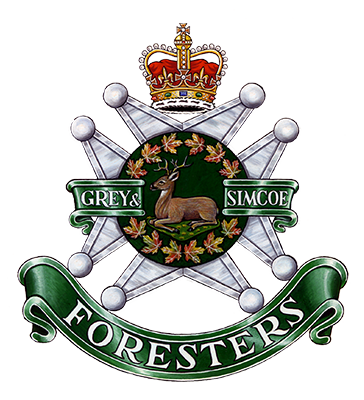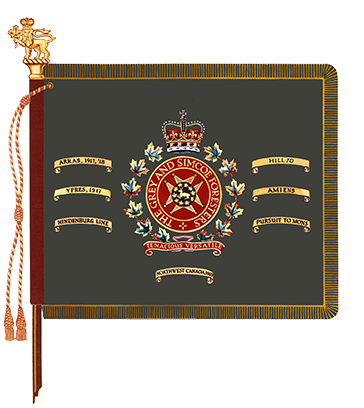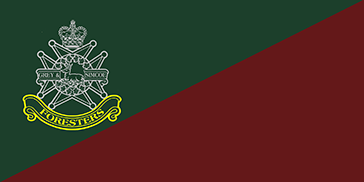The Grey and Simcoe Foresters
The official lineage of The Grey and Simcoe Foresters infantry regiment.

Colonel-in-Chief: Her Royal Highness The Princess Royal LG LT GCVO QSO GCL CD FRS
Badge
Description
A pomme charged with a stag lodged on a mount within a circle of autumnal maple leaves proper overall on either side a scroll Vert inscribed GREY and and SIMCOE in letters Argent, the whole surmounting a Maltese cross pommé Argent ensigned by the Royal Crown proper and resting on a scroll Vert inscribed FORESTERS in letters Argent.
Symbolism
The maple leaves represent service to Canada, and the Crown, service to the Sovereign. The badge of the regiment is styled on that of their former British allied regiment The Sherwood Foresters (Nottinghamshire and Derbyshire Regiment) (now, through amalgamation, The Mercian Regiment), whose badge, in turn, was based on that of the 95th (Derbyshire) Regiment, which featured a Maltese cross (based on the insignia of the Royal Guelphic Order), and that of the 45th (Nottinghamshire - Sherwood Foresters) Regiment, which featured a stag. The words "GREY and SIMCOE" and "FORESTERS" are a form of the regimental title.
Motto
None
March
"The 31st Greys"
Alliance
British Army
The Mercian Regiment
Regimental colour

Camp flag

Battle honours
North West Campaign
NORTH WEST CANADA, 1885.
The First World War
ARRAS, 1917, '18; HILL 70; YPRES, 1917; AMIENS; HINDENBURG LINE; PURSUIT TO MONS.
South-West Asia
AFGHANISTAN
Lineage
This Reserve Force regiment originated on 14 September 1866 and incorporates the following regiments.
The Grey and Simcoe Foresters originated in Owen Sound, Ontario on 14 September 1866, when the '31st "Grey Battalion of Infantry"' was authorized to be formed.Footnote 1 It was redesignated: '31st Grey Regiment' on 8 May 1900;Footnote 2 and 'The Grey Regiment' on 1 May 1920.Footnote 3 On 15 December 1936, it was amalgamated with 'The Simcoe Foresters' (see below) and redesignated 'The Grey and Simcoe Foresters'.Footnote 4 It was redesignated: '2nd (Reserve) Battalion, The Grey and Simcoe Foresters' on 7 November 1940;Footnote 5 and 'The Grey and Simcoe Foresters (Reserve)' on 1 November 1943.Footnote 6 The regiment was converted to artillery and redesignated the '45th Anti-Tank Regiment (Grey and Simcoe Foresters), RCA' on 1 April 1946;Footnote 7 and '45th Anti-Tank Regiment (Self-Propelled) (Grey and Simcoe Foresters), RCA' on 19 June 1947.Footnote 8 On 1 October 1954, it was amalgamated with the '55th Light Anti-Aircraft Regiment, RCA', (see below), converted to armour and redesignated 'The Grey and Simcoe Foresters (28th Armoured Regiment)';Footnote 9 and 'The Grey and Simcoe Foresters (RCAC)' on 19 May 1958.Footnote 10 It was converted to infantry and redesignated 'The Grey and Simcoe Foresters' on 1 September 1970.Footnote 11
Notes:
Upon redesignation as The Grey Regiment on 1 May 1920 (see above), it was organized as a two battalion regiment with the 1st Battalion (147th Battalion, CEF) on the Non Permanent Active Militia order of battle, and the 2nd Battalion (no CEF designation) on the Reserve order of battle. The reserve unit was disbanded on 14 December 1936 (GO 3/37).
The Grey Regiment was disbanded for the purpose of reorganization on 1 March 1921 and reorganized the same day (GO 118/21). This change was administrative and does not affect the lineage of the regiment.
The Grey Regiment was disbanded for the purpose of amalgamation on 14 December 1936 and reorganized the next day (GO 163/36). This change was administrative and does not affect the lineage of the regiment.
The Simcoe Foresters originated in Barrie, Ontario on 14 September 1866, when the '35th "Simcoe Battalion of Infantry"' was authorized to be formed.Footnote 12 It was redesignated: '35th Battalion "The Simcoe Foresters"' on 5 April 1867;Footnote 13 '35th Regiment "Simcoe Foresters"' on 8 May 1900;Footnote 14 and 'The Simcoe Foresters' on 1 May 1920.Footnote 15 On 15 December 1936, it was amalgamated with 'The Grey Regiment', as above.
Notes:
Upon redesignation as The Simcoe Foresters on 1 May 1920 (see above), it was organized as a two battalion regiment with the 1st Battalion (157th Battalion, CEF) on the Non Permanent Active Militia order of battle, and the 2nd Battalion (177th Battalion, CEF) on the Reserve order of battle. The reserve unit was disbanded on 14 December 1936 (GO 3/37).
The Simcoe Foresters were disbanded for the purpose of reorganization on 15 December 1920 and reorganized the same day (GO 43/21). This change was administrative and does not affect the lineage of the regiment.
The Simcoe Foresters were disbanded for the purpose of amalgamation on 14 December 1936 and reorganized the next day (GO 163/36). This change was administrative and does not affect the lineage of the regiment.
The 55th Light Anti-Aircraft Regiment, RCA originated in Windsor, Ontario on 1 April 1946, when the '55th Light Anti-Aircraft Regiment, RCA' was authorized to be formed.Footnote 16 On 1 October 1954, it was amalgamated with the '45th Anti-Tank Regiment (Self-Propelled) (Grey and Simcoe Foresters), RCA', as above.
Perpetuations
'147th', '157th', '177th' and '248th Canadian "Overseas" Battalion(s), CEF'
Headquarters Location
Owen Sound, Ontario
Operational history
North West Campaign
The 35th Battalion "The Simcoe Foresters" mobilized four companies for active service on 10 April 1885.Footnote 17 The companies served with the 'York and Simcoe Provisional Battalion' as part of the Alberta Column of the North West Field Force.Footnote 18 The companies were removed from active service on 24 July 1885.Footnote 19
The First World War
Details of the 35th Regiment "Simcoe Foresters" were placed on active service on 6 August 1914 for local protection duties.Footnote 20
The 147th Battalion, which was authorized on 22 December 1915 as the '147th "Overseas" Battalion, CEF',Footnote 21 embarked for Great Britain on 14 November 1916.Footnote 22 Its personnel were absorbed by the '8th Reserve Battalion, CEF' on 1 January 1917 to provide reinforcements to the Canadian Corps in the field.Footnote 23 The battalion was disbanded on 1 September 1917.Footnote 24
The 157th Battalion, which was authorized on 22 December 1915 as the '157th "Overseas" Battalion, CEF',Footnote 25 embarked for Great Britain on 17 October 1916.Footnote 26 Its personnel were absorbed by the '1st', '19th, '116th' and '125th "Overseas" Battalion, CEF' between 28 October and 8 December 1916 to provide reinforcements to the Canadian Corps in the field.Footnote 27 The battalion was disbanded on 1 September 1917.Footnote 28
The 177th Battalion, which was authorized on 15 July 1916 as the '177th "Overseas" Battalion, CEF',Footnote 29 embarked for Great Britain on 3 May 1917.Footnote 30 Its personnel were absorbed by the '3rd Reserve Battalion, CEF' on 14 May 1917 to provide reinforcements to the Canadian Corps in the field.Footnote 31 The battalion was disbanded on 15 April 1918.Footnote 32
The 248th Battalion, which was authorized on 1 May 1917 as the '248th "Overseas" Battalion, CEF',Footnote 33 embarked for Great Britain on 2 June 1917.Footnote 34 Its personnel were absorbed by the '8th Reserve Battalion, CEF' on 21 June 1917 to provide reinforcements to the Canadian Corps in the field.Footnote 35 The battalion was disbanded on 15 September 1917.Footnote 36
The Second World War
The regiment mobilized the 'The Grey and Simcoe Foresters, CASF' for active service on 24 May 1940.Footnote 37 It was redesignated: '1st Battalion, The Grey and Simcoe Foresters, CASF' on 7 November 1940;Footnote 38 and, after it was converted to armour, '26th Army Tank Battalion (The Grey and Simcoe Foresters), CAC, CASF' on 26 January 1942;Footnote 39 and '26th Army Tank Regiment (Grey and Simcoe Foresters), CAC, CASF' on 15 May 1942.Footnote 40 It embarked on 17 June 1943 for Great Britain.Footnote 41 The regiment was disbanded on 1 November 1943.Footnote 42
South-West Asia
De 2002 à 2014, The Grey and Simcoe Foresters ont renforcé diverses unités des FAC déployées en Afghanistan.Footnote 43